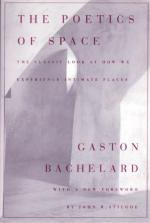
|
| Name: _________________________ | Period: ___________________ |
This test consists of 15 multiple choice questions and 5 short answer questions.
Multiple Choice Questions
1. What image does Bachelard propose to give a door sacred character?
(a) Opaque peep holes.
(b) A mythical threshold god.
(c) An elaborate molding.
(d) Elaborate locks and keys.
2. What is forgotten by Milosz's cynical character?
(a) Childhood memories.
(b) Nothing.
(c) Everything.
(d) Recent happy times.
3. Through a magnifying glass, what does the first view of any phenomenon become in the author's opinion?
(a) A matter of scientific observation.
(b) A revelation of never-before-seen flaws.
(c) A miniature universe.
(d) A disruption of poetic thought.
4. What is the term for the fear of open space?
(a) Hydrophobia.
(b) Agoraphobia.
(c) Arachnophobia.
(d) Claustrophobia.
5. Poets, states Bachelard, use words to bring together what two entities?
(a) Inside and outside.
(b) Earth and sky.
(c) Individual and universe.
(d) Past and present.
6. How does Bachelard refer to words?
(a) Little houses with their own sense of space.
(b) Leaves in an endless forest.
(c) Locked boxes filled with mysteries.
(d) Shells that conceal identies.
7. For Bachelard, what does the metaphor of old forests that go on without limit represent?
(a) A search for fantasy.
(b) Man's search deep within.
(c) Immortality.
(d) A yearning for the childhood house.
8. The cynical character created by the poet Milosz reminisces where?
(a) In a tree.
(b) In his palace.
(c) In church.
(d) In a boat.
9. What are two opposing truths introduced by Bachelard in "Corners" regarding corners?
(a) Corners can be clean or neglected.
(b) Corners can be solid or weak.
(c) Corners can be real or imaginary.
(d) One can be at peace in a corner or can be cornered there.
10. For Bachelard, what is amusing about space images?
(a) All complications can be eliminated from consideration.
(b) Space images evoke childhood happiness.
(c) Space images represent impossibilities.
(d) Poetic space images of today become the reality of tomorrow.
11. How is Tom Thumb killed?
(a) By the kick of an ant.
(b) By a snail.
(c) By a grain of dust.
(d) By the footsteps of a larger man.
12. Contrary to the intellectual philosopher, states Bachelard, a poet may use words in what way?
(a) To describe the origins of man.
(b) To create false illusions.
(c) For rhythm and rhyme, rather than meaning.
(d) For sensitivity rather than precision.
13. In the work of Milosz, how did he indicate that corners are not always safe?
(a) Corners are sometimes bug-filled.
(b) Corners can be hard and cold.
(c) Corners are pointy when inverted.
(d) Corners are sometimes hiding places.
14. Who lives in the new that guides the phenomenologist in Bachelard's opinion?
(a) The psychologist.
(b) The poet.
(c) The scientist.
(d) The psychoanalyst.
15. What does a phenomenologist look for?
(a) New theories.
(b) Sexually-obsessed behavior.
(c) Poetic inspiration.
(d) Observable facts or events.
Short Answer Questions
1. Bachelard believes that what must flow within in order to appreciate the dream process?
2. Bachelard believes that, for Baudelaire, immensity is a category of what?
3. How does Tom Thumb's stature become believable?
4. What does every corner or angle in a house symbolize for Bachelard?
5. According to Bachelard, what term can describe the emergence of being through poetry and contemplation of poetic immensity?
|
This section contains 516 words (approx. 2 pages at 300 words per page) |

|




